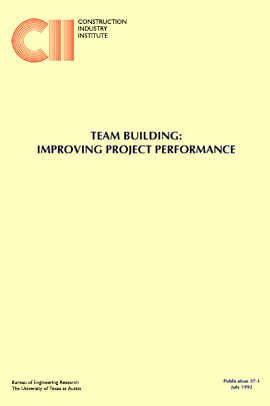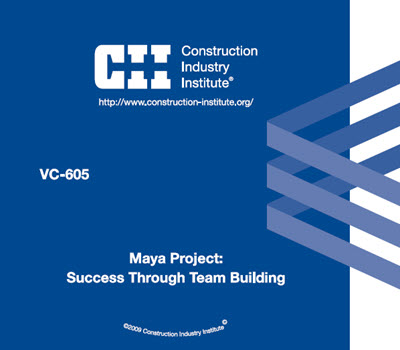
Team Building: Improving Project Performance
An effective team building process can bring significant, not simply marginal, improvements in project execution and results. Use of team building represents a “step change” in the way projects are managed and in the ultimate project performance. The purpose of this publication is to demonstrate how these statements are supported by research and case studies.
It is not uncommon during the design/construction process for an adversarial relationship to develop among the parties involved, usually the project owner, designer and contractor. Since this type of relationship is seldom constructive and frequently the cause of problems, CII formed the Project Team Building Task Force to examine how the adversarial relationship might be minimized.
Through a series of meetings, literature review, three mail surveys and personal interviews, the task force defined the research problem and conducted its research. This publication contains the major findings, conclusions and recommendations of the research.
The Team Building Process. This publication does not address “teams,” per se: it addresses the team building process. What is the team building process? It is a process that brings together a diverse group of individuals and seeks to resolve differences, remove roadblocks and proactively build and develop the group into an aligned, focused and motivated work team that strives for a common mission and for shared goals, objectives and priorities.
The reader will not find a “how-to-do-it” manual on team building here, but rather will learn about the results of its use on a wide variety of construction projects. While no effort has been made to prescribe the methods by which successful team building should be done, common elements were found, which include:
- Use of a consultant who does not have a direct stake in the outcome of the project.
- At least one “retreat” type meeting of the group in which the shared goals are spelled out and essential decision-making and dispute resolution procedures are worked out.
- Regular job site meetings of the team (at which the consultant need not be present).
- Follow-up meetings to reinforce concepts and to integrate new members.
On most projects studied during the research, individuals that participated in the team building process were from three different organizations—the owner, designer and contractor. On the remaining projects, team members were from only two of these organizations. Occasionally, team members included other major stakeholders such as subcontractors and construction managers.
Major research findings:
- Adversarial relationships are common but not universal, have several major causes, and can have a detrimental impact on project costs and results, but can be reduced or eliminated by use of the team building process.
- Project team building was used successfully regardless of the type of commercial relationship (“lump sum” or “cost reimbursable” contract) among the parties.
- The decision to use the team building process was made primarily because the process was viewed as a proactive way to manage a project in a “win-win” environment.
- The team building process forms a group into an aligned, focused and motivated work team that strives for a common project mission.
- The costs associated with using team building are minuscule when compared to the benefits received.
- All interviewees on all of the projects studied in this research said they would use team building again!
Major conclusions:
- Successful use of the team building process will bring to the design/construction process significant and cost effective short-term and long-term benefits.
- The major motivation for using the team building process on the projects studied was to improve project results.
- Confusion can be reduced by distinguishing between the team building process and “partnering.” They are different forms of collaboration among owner, designer, and contractor even though the two terms often are used interchangeably.
- The successful use of project team building is independent of the specific type of commercial relationship that is used by the parties to the project.
- Owners, designers, and contractors provided essentially similar responses to questions asked in this research.
- The costs of conducting the team building process are best thought of as a small investment that yields a high rate of return.
- Adversarial relationships among a project owner, designer and/or contractor are common but not inevitable.
- Previous experience with the team building process is not a precondition for having effective teams.
- Implementing the team building process is facilitated by the use of a consultant, either from inside or outside one of the involved organizations.
- There is no “one best way” to facilitate the team building process. Different facilitating styles can lead to effective project teams.
- The team building process is not a management panacea, but is one technique that, if effectively applied, can contribute important benefits.
Major recommendations:
- Use the team building process.
- Use a consultant to facilitate the process.
- Begin the process early in the life of the project.
- Seek broad participation in the process.
- Make the process an integral part of project management.
Working relations among a project owner, designer, and/or contractor frequently are characterized by mistrust, poor communication and cooperation, and an adversarial nature. However, while such relationships are frequent, they are not the norm. (RS37-1, p. 6)
- Poorly defined scope of project
- Excessive change orders
- Changes not properly managed
- Lack of communication of objectives
- Unrealistic project schedule and unrealistic project budget
(RS37-1, p. 6)
The two causes cited as having the most severe impact on project costs and results are:
- Poorly defined scope
- Excessive change orders
(RS37-1, p. 7)
Project team building was used successfully regardless of the type of commercial relationship (lump sum or cost reimbursable contract) among the parties. (RS37-1, p. 7)
The costs associated with using team building are minuscule when compared to the benefits received. Those benefits may include reduced adversarial relationships, lower project costs, improved project quality, shorter project schedules, and a commitment to future use of team building. (RS37, p. 9)
Effective project teams are characterized by trust, shared goals, interdependence, a shared commitment to work together, a shared sense of accountability, pride in team members, open communication, and giving team members a lot of feedback. (RS37-1, p. 12)



